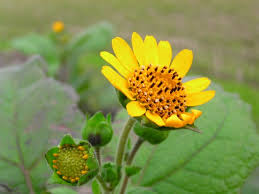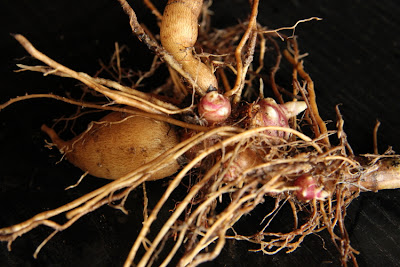Yacon
(Smallanthus
sonchifolius formerly known as Polymnia sonchifolia) is a perennial root vegetable from South America.
If you have never eaten yacon then you are missing out on something truly special.
When Tracey asked our five year old to describe
yacon he said: "
They taste like apple. They look like a tube and grow underground like a potato. The leaves feel like a soft blanket." To be honest I think that is as good a description as any.
How I first grew yacon
I read about yacon years ago on the Lost crops site and eventually tracked down a small rhizome to buy over the internet. I spent a bit of money to get yacon and had no idea if it would grow for me or even if I would like it. You plant yacon in spring, then you wait as it grows happily, if you have frosts it is best to let it die down over winter before harvest. After planting it I waited patiently as it grew, still never having tasted it, all the while tempted to dig up a small root to try but trying to be patient so the plant could do its thing properly. The yacon grew about waist high and looked nice, towards the end of the growing season it dropped a few leaves and looked a bit shabby. The yacon then grows a small yellow sunflower like flower some years, unfortunately they require more than one clone in order to set viable seed and as far as I am aware there is only one yacon clone in Australia.
 |
| Yacon flowers |
Then winter came, I was very excited, but the frosts did not kill off the tops so I waited until we had a hard frost as frost apparently makes the roots sweeter. We then had a hard frost, and the yacon looked a little burned but overall was not too bothered, even though it does not look like it yacon is a pretty hardy plant. After a few hard frosts the tops eventually succumbed to the cold. I carefully dug up the large and brittle tubers and tried one, I liked it but it was nothing special. The yield was amazing, from the one tiny rhizome that I initially planted I ended up with a dozen much larger rhizomes and a bucket full of large tubers, but if the taste was not great I did not want to use the space on them regardless of the yield. Everything I had read said that if you leave yacon for a few weeks after digging it up it gets sweeter, so I waited for a few weeks for the tubers to sweeten, I then tried another one, I loved it!
I wish that yacon was more readily available in Australia, even if the plants were more available for people to grow at home it would be great, this is why I started to sell plants. I am rather fond of perennial vegetables, once you plant them you pretty much will have them forever.
 |
| Yacon, note the light brown edible tuber and the purple propagative rhizome |
How to grow yacon
I have included some growing notes
here that describes things a bit more clearly. Yacon are interesting plants to grow, they pretty much look after themselves, they are hugely productive, and they are perennial. From what I have read it can grow and be harvested all year in frost free places, apparently without frost you just wait an extra couple of days after harvest to let it sweeten before eating it.
I have never heard of anyone who has grown yacon complain of any pest or disease that affects the plants. Yacon seems not overly picky about soil conditions, planted in rich moist soil it gives the highest yields, but it still gives a decent yield on poor soil with minimal water. Yacon prefers full sun but will also provide a decent yield in part shade, it is well suited to growing under trees to utilise an otherwise wasted space. One thing that yacon does not like is rocks and stones in the soil, the tubers will still grow and give a large and delicious yield but they will be misshapen due the pressure exerted upon them from the stones etc in the soil.
Unlike jerusalem artichokes to which yacon is related, yacon poses no weed threat, it grows well yet it remains civilised by not taking over the vegetable garden, in fact other plants seem to grow better when yacon is grown near them. Yacon exudes inulin and other sugars from its roots which attracts and feeds earth worms as well as a host of other beneficial soil life. I am told that yacon is readily colonised by mycorrhizae which promote plant growth in a number of ways.
 |
| Purple Yacon rhizomes ready to be divided and planted |
Yacon is edible, delicious and healthy
Another civilised thing about yacon is that every part is edible as well as being good for you. Some other vegetables have some parts you can eat and others you can not, or some things which must be eaten cooked as they are toxic if raw, or irritating hairs or spines that must be dealt with, all parts of yacon can be eaten either raw or cooked. The large sweet crunchy tubers are the part that we like the best, we do not tend to eat any other parts. Mostly we eat the tubers raw, some people just dig them up and eat them as is but I peel them as the skin can taste a little like resin. I find that if I slice them thin they taste the best.
Yacon is crunchy and sweet, after cooking it retains its crunch but tends to take on the flavour of whatever it is cooked with. It can be used in the place of water chestnuts in recipes. Even though yacon is very sweet the sugars are not digested by people which makes it fine to be eaten by diabetics. Yacon is high in inulin (which is different to insulin), inulin is a natural prebiotic which feeds the good bacteria in your body and helps to exclude the bad bacteria. This means that as well as tasting great yacon is good for you.
Once harvested yacon tubers seem to last anywhere from a few months to a year depending on climate in which they are stored. One year we had far too many yacon tubers so decided to freeze some of them. Once frozen they last seemingly forever. To eat them it is important not to thaw them as they go black and slimy looking. I remove the tubers from the freezer, peel them with a vegetable peeler, slice them and eat them. When frozen yacon tubers are easy to peel and easy to slice. When frozen yacon tastes different to when it is raw, it is difficult to describe but it kind of tastes like frozen banana custard. My kids seem to like frozen yacon even more than they like raw yacon.
Another remarkably civilised thing about yacon is that the part that you eat is different to the part that you plant to grow a crop for next season. Unlike other vegetable crops where you have to decide how much to eat and how much to save to replant or you have to decide how many plants to let go to seed, you eat all of the yacon tubers and plant all of the propagative rhizomes. As yacon is propagated by division and does not produce seed you do not have to worry about caging or separating to keep seed pure or growing enough plants to avoid inbreeding depression. Growing yacon by divisions means you never have to worry about the neighbours growing GM crops that will cross pollinate and ruin your plants, the yacon that we grow and eat today is genetically the same as the yacon plants that the Incas domesticated and grew.
 |
| Small yacon plant almost ready to be harvested after frost |
Harvesting Yacon
The different parts of yacon are easy to tell apart as the tubers are large and brown and look like sweet potato, the propogative rhizome is purplish and small and has growing points, you will see these when you harvest yacon.
I look forward to yacon harvest each year, not only because it means that in a few weeks I will be eating sweet yacon, but also because of the unmistakable yacon smell. It is a smell that can't be described, a smell that says that winter is here, a smell that helps keep me connected to the land and the seasons, a smell I miss over the rest of the year. When we harvest yacon I carefully dig/pull up a plant and shake it gently. The edible tubers fall off in a civilized pile and what is left in my hand is for dividing and replanting.
 |
| Yacon leaf, it "feels like a soft blanket" |
The leaves are large and fuzzy, as Igloo says they "feel like a soft blanket". I have heard that in Peru the leaves are used to wrap food before it is cooked, kind of like a banana leaf or a grape leaf, but I am yet to try this myself. A herbal 'tea' can be made from the leaves which helps to even out blood sugar. The leaves can be picked and used straight away, or they can be left somewhere out of the sun to dry and then used to make the herbal tea later. Unlike many herbal claims this claim that yacon leaves lower blood sugar levels seems to have been tested and proven to be true. I have only made tea from the leaves once and found the taste to be a little odd, kind of like peppermint mixed with something. I didn't really like it, but I didn't hate it, I am glad to say that the taste was not very strong. It would probably taste nice if you mixed it with something that tastes better or something that has a strong taste that would overpower the yacon.
Where to buy yacon plants in Australia
As I already mentioned, if you have not eaten yacon you are missing out on something really special. The chances are that you will never see yacon in the supermarket, so if you plan to try some or if you want your children to try some you must grow your own. I do sell yacon rhizomes (a bit larger than the ones in the pictures above)
here.
Ecclesiastes 3:1-2 There is a time for everything, and a season for
every activity under the heavens; a time to be born and a time to die, a
time to plant and a time to uproot,









